TV Tune-In: Nielsen Case Studies Prove AM/FM Radio Ad Campaigns Drive +33% Lift In TV Viewership
The ability to measure AM/FM radio’s ability to drive viewership to TV premieres and events is now exceptionally accurate. Nielsen’s “Promo Effect” study uses the 80,000-person Portable People Meter panel.
TV show viewership is examined among those exposed to TV tune-in AM/FM radio ads and those who did not hear the AM/FM radio ads. The difference in TV audiences between those exposed and not exposed is the “lift” generated by the AM/FM radio ads.
Campaign weight is important: AM/FM radio TV tune-in campaigns should be least 150 GRPs and generate a minimum 45% reach
Buying a little bit of AM/FM radio on the day of TV show’s premiere is “spray and pray,” an insufficient investment yielding tiny amounts of reach. To make an impact, TV tune-in AM/FM radio campaigns should generate at least a 45% reach via 150 GRPs.

While TV promos reach the heavy TV viewers, AM/FM radio ads drive awareness and interest among medium/light TV viewers
TV promos for shows on a network do a great job of reaching heavy TV viewers and existing network viewers. AM/FM radio ads excel at reaching light/medium TV viewers who miss promos and paid TV ads running on other networks and cable.
A series of five incremental reach studies conducted by Nielsen reveals AM/FM radio ads excel at impacting hard to reach medium and light TV viewers. Across the five campaigns, AM/FM radio ads generated a +78% lift in incremental reach among light TV viewers.
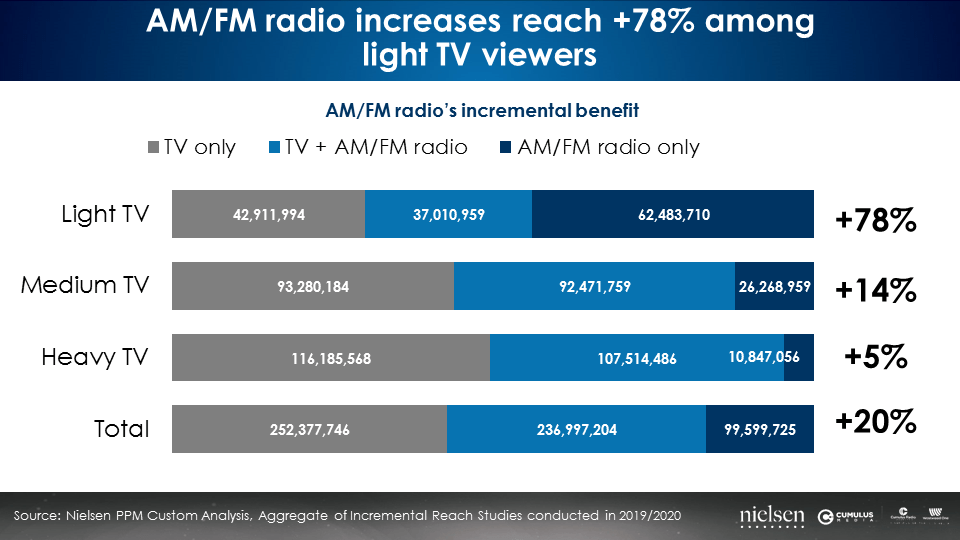
Here are three TV tune-in case studies measured by Nielsen’s “Promo Effect” service.
Case study: Eight-episode documentary mini-series
The AM/FM radio campaign lasted four weeks, the two weeks leading up to the launch and during the ten-day period of the mini-series. CUMULUS MEDIA | Westwood One retained Nielsen to measure TV audiences for each episode from live viewing up to seven days of time-shifted exposure.
The AM/FM radio campaign generated a +52% lift in viewership to the series. The younger the demographic, the greater the lift of TV tune-in. Exposure to the AM/FM radio campaign drove a +28% lift in TV audiences among 55+ viewers and an +86% increase among persons 25-54. Among Millennials 18-34, there was a +119% lift.
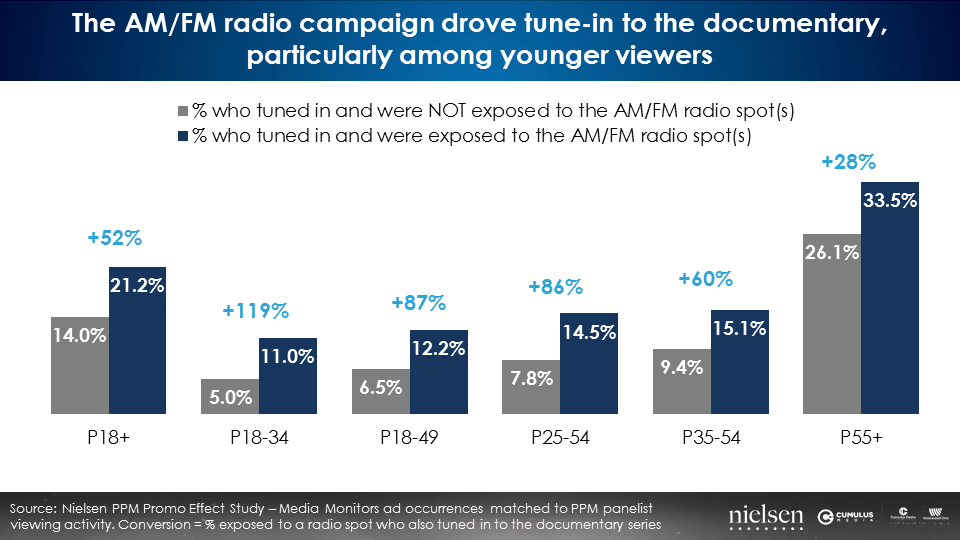
Among those who watched multiple episodes of the mini-series, the AM/FM radio campaign generated the greatest tune-in lift.
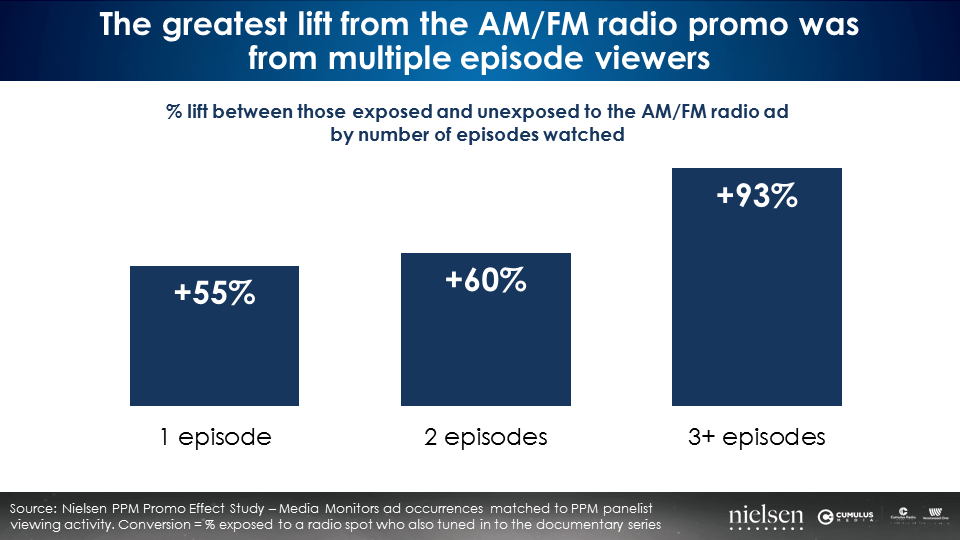
The frequency sweet spot occurred among those exposed two or three times to the AM/FM radio tune-in campaign. Viewership among persons 18-54 was double among those exposed two or three times to the AM/FM radio campaign (15%) versus those who were not exposed to the AM/FM radio campaign (7.4%).
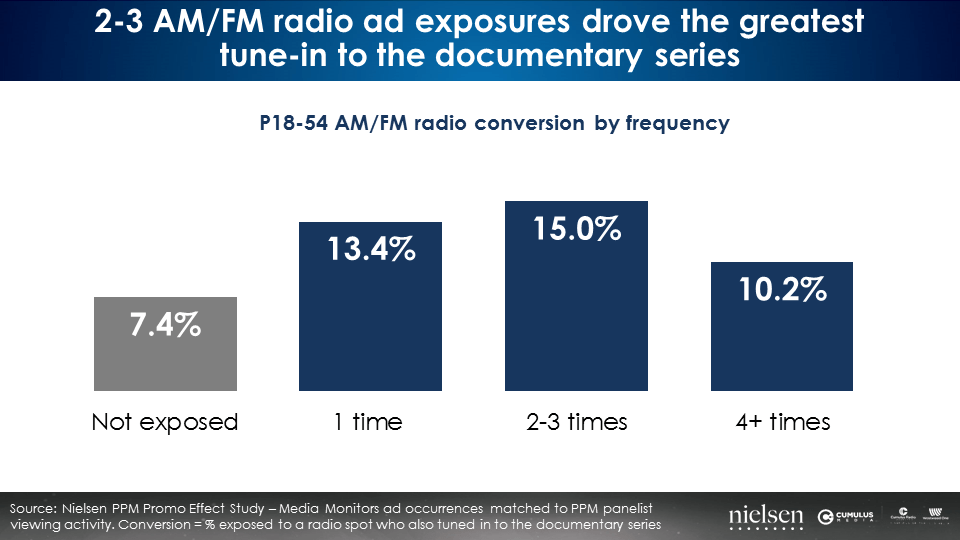
Case study: Returning season for a scripted drama
A major cable network used AM/FM radio to help launch the returning season of a scripted drama series. Their media plan also included paid TV and promos running on their network and co-owned networks.
CUMULUS MEDIA | Westwood One retained Nielsen to study how AM/FM radio impacted the marketing mix of TV promos and paid TV.
AM/FM radio accounted for a small percentage of the media budget but generated significant impressions and incremental reach. Although AM/FM radio only represented 5% of paid media, it delivered 20% of total campaign impressions.
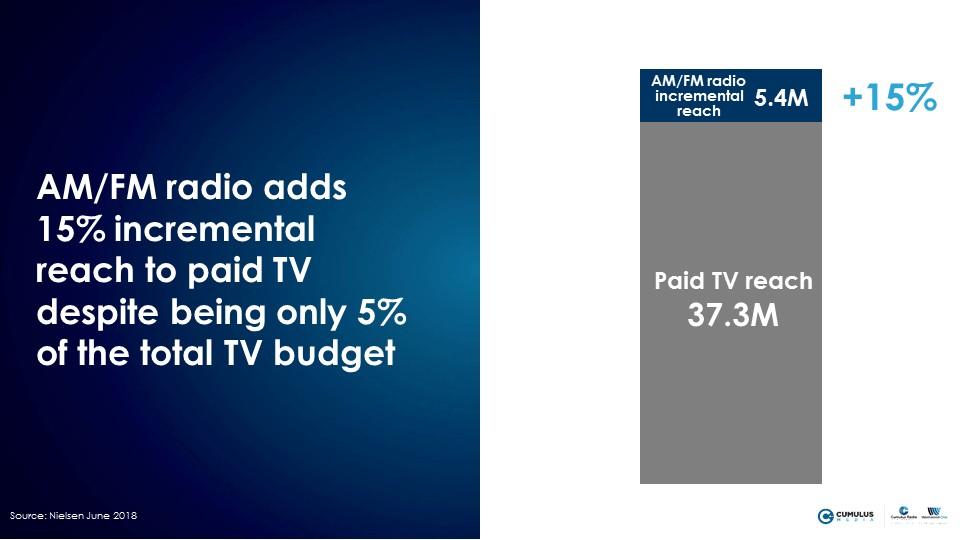
The paid TV campaign reached 37.3 million Americans. AM/FM radio added an incremental audience of +15%, bringing 5.4 million new sets of eyes to watch the series.
Compared to TV, AM/FM radio delivered a much younger audience. 70% of AM/FM radio impressions came from 18-54-year-olds. Conversely, nearly half of all the TV impressions were from 55+.
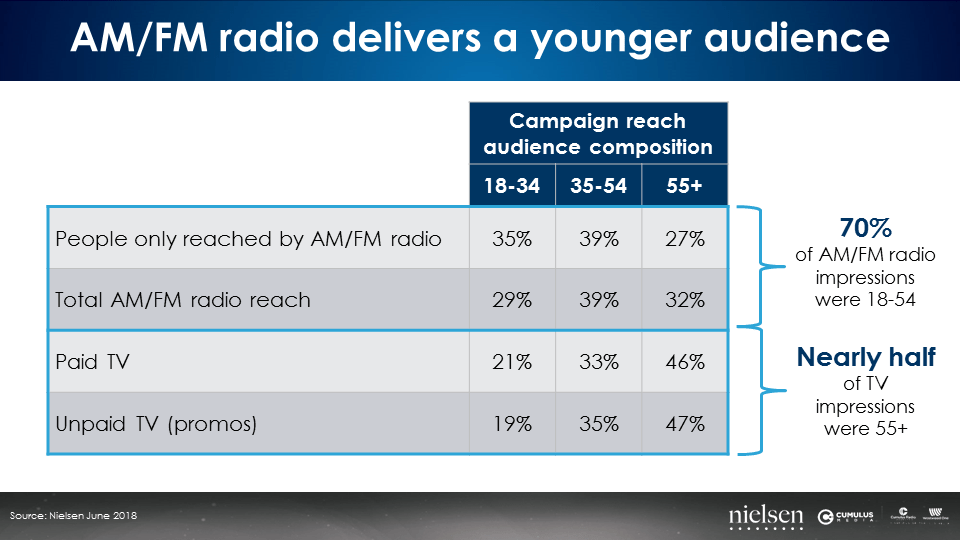
From a cost standpoint, AM/FM radio’s reach and impressions were achieved much more efficiently. AM/FM radio is only 20% of TV’s CPM and cost per thousand net reach.

Case study: Two-week historical mini-series
A major national television network advertised a two-week run of a historical mini-series on the Westwood One network. In the first-ever study of AM/FM radio’s effect on television tune-in for this network, CUMULUS MEDIA | Westwood One partnered with Nielsen to study how exposure to the AM/FM radio campaign resulted in increased TV tune-in.
Among persons 18+, those who were exposed to the AM/FM radio campaign were +44% more likely to tune-in to the program than those who were not exposed.
Among persons 25-54, there was a +27% viewing lift among those exposed. AM/FM radio successfully grew interest in the program and directly influenced tuning behavior.
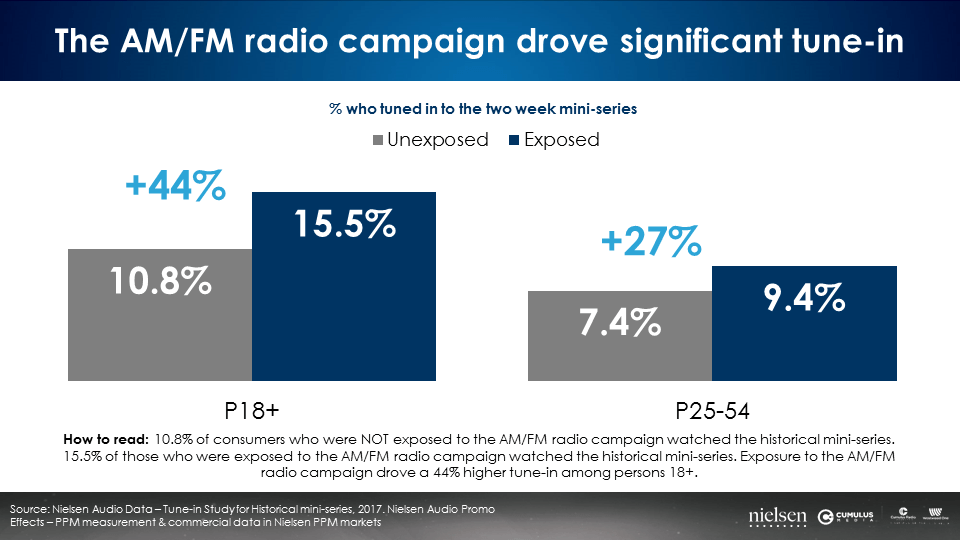
88% of viewers delivered by AM/FM radio were new or light network viewers. AM/FM radio was particularly successful in driving tuning behavior beyond the network’s core viewers.
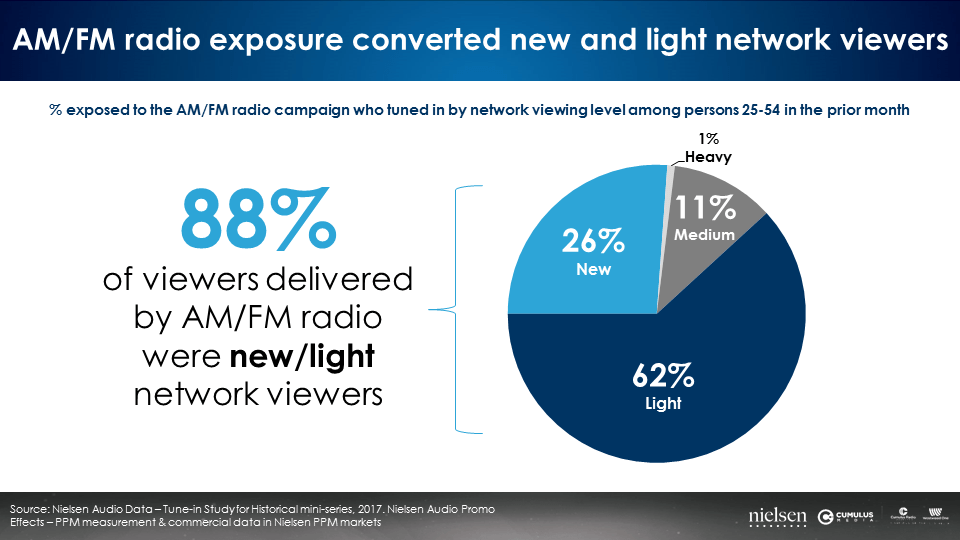
AM/FM radio generates an average +33% TV tune-in lift: Fifteen studies conducted by Nielsen over four years
In addition to these individual examples of AM/FM radio’s ability to drive tune-in, Nielsen found a powerful pattern that emerged over the course of fifteen case studies conducted across four years. Among viewers who tuned into a program, persons who were exposed to an AM/FM radio ad were +33% more likely to tune in compared to viewers who were not exposed to AM/FM radio ads. For TV campaigns needing to drive viewership, AM/FM radio makes tune-in campaigns better.
Key takeaways:
- To be effective, TV tune-in campaigns on AM/FM radio require a 45% weekly reach and at least 150+ GRPs. Buying a handful of GRPs on premiere day is “spray and pray” ineffectiveness.
- Nielsen’s “Promo Effect” study is the ultimate “closed loop” ROI study. Via the PPM panel it captures both commercial audiences to AM/FM radio TV tune-in commercials and the impact on viewership lift to the TV program.
- While on-network promos and paid TV buys reach heavy TV viewers, AM/FM radio TV tune-in campaigns reach medium and light TV viewers.
- AM/FM radio campaigns generate outsized incremental reach and audiences among younger demographics. As such, the younger the demo, the greater the lift in TV tune-in viewing.
- An eight-part documentary series used AM/FM radio to generate a +52% lift in viewing and an even greater increase of multi-episode tuning.
- The returning season of a scripted cable drama ran an AM/FM radio campaign that represented only 5% of the media plan but generated 20% of the total campaign impressions. 70% of the AM/FM radio impressions were from persons 18-54, while half of the paid TV and TV promo impressions were from persons 55+.
- A historical mini-series AM/FM radio tune-in campaign generated a +44% increase in viewing. The vast majority of the viewers AM/FM radio delivered were new and light viewers of the network.
- Fifteen Nielsen case studies across four years revealed that among viewers who tuned into a program, persons who were exposed to an AM/FM radio ad were +33% more likely to tune in compared to viewers who were not exposed to AM/FM radio.
Pierre Bouvard is Chief Insights Officer at CUMULUS MEDIA | Westwood One.
Contact the Insights team at CorpMarketing@westwoodone.com.